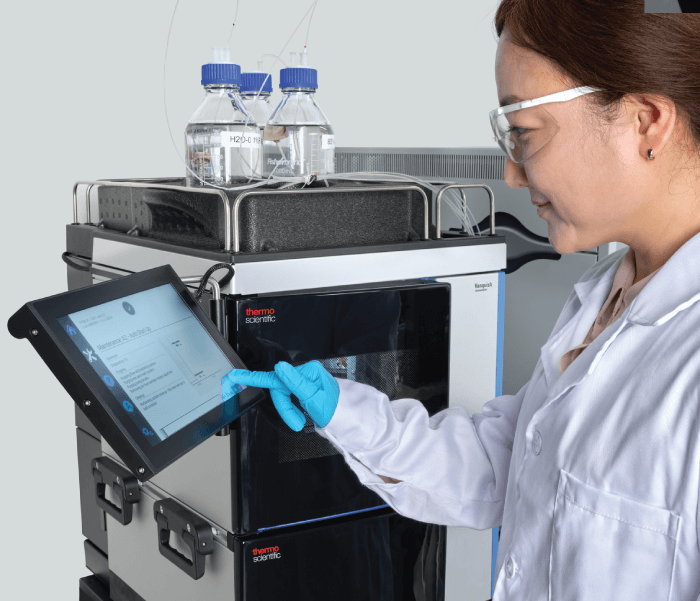Presenting highlights from the webinar “Beyond the boundaries of LC-MS proteomics with next-generation all-in-one nano-, capillary- and micro-flow LC,” which is now available to view on demand here
After listening to feedback from researchers, day-to-day instrument users, laboratory managers, and engineers, Thermo Fisher Scientific identified a number of crucial attributes for the next generation of low-flow LC systems:
i) performance: getting deeper into quantitative proteomics, bioanalysis or biopharma while maintaining high sensitivity and separation power,
ii) robustness: delivering high-quality results 24/7, iii) ease of use: ensuring results are easy to obtain for users with varying levels of LCMS expertise.
And the Vanquish Neo UHPLC system has it all. Indeed, this nano-, capillary- and micro-flow system for high-performance LCMS workflows enables long-term, troublefree analysis and seamlessly integrates with the Thermo Scientific MS portfolio. The new system is designed for a range of applications, from single-cell analysis to routine quantification of peptides and posttranslational modifications. Below, David Perlman, Bernhard Kuster, and Karl Mechtler share their experience of using the Vanquish Neo UHPLC system in the wild.

David Perlman is the Senior Principal Scientist and Director of Ultrasensitive Proteomics, Merck Exploratory Sciences Center, Cambridge, MA, USA

As you can tell from the title of my talk, my team is extremely interested in single-cell proteomics. We are very excited by the potential for this new field to have an enormous impact on our understanding of the cellular functional heterogeneity that defines human health and disease. Every technology that helps us further towards this goal is more than welcome.
We ran a technical assessment of the Vanquish Neo and it demonstrated extraordinary reliability, performance flexibility, and ease-of-use through our entire testing period. It has enabled the comparative assessment of highperformance column systems and their flow rate optimization, including testing the cost and benefits of ultra-low flow rates. Its consistent performance has really facilitated our MS run parameters to maximize not only identification but also peptides quantification. In terms of our single-cell application, we created a family of single-cell proteomics quality control standards for multiplex SCoPE-MS type experiments using commercially available peptide digest products from two separate human cell lines.
We continue to be impressed with the ongoing robustness of the Vanquish Neo platform. It has been in continuous use in our lab 24/7 for 9 months now and counting. We use it in challenging high-pressure nanoflow applications with multiple different column systems that we swap in and out, as well as multitude of different gradients. So far, we have had flawless operation with not a single day of downtime or service required. That track record is impressive, particularly in the historic context of nano-flow systems. The Vanquish Neo autosampler itself is masterfully engineered. I’ve had a great deal of experience with other systems in the past; maintaining continuous high-performance operation month after month was frequently a challenge, and upkeep was laborious. The Vanquish Neo has reset my own expectations for productivity on our platform and helped identify where our weakest links may lie.
Because we were among the first to test the Vanquish Neo – and because it has only just recently entered the market – we have only really been able to share our own experiences. I know that my positive feedback has been welcome news – everyone likes to hear of solutions to problems that they are also experiencing. And I might add our early feedback is backed up by our own purchasing choices: once the Vanquish Neo became commercially available, we ordered two more systems for my own group, and are planning to purchase one more unit this quarter. Nothing speaks louder than that – and it’s simply a reflection of the degree of our own personal excitement for this product.
Karl Mechtler is Head of the Protein Chemistry Facility, Research Institute of Molecular Pathology, Vienna Biocore Facilities, Austria

We’ve used the system for deep-dive proteome profiling with nanoLC-MS and high-performance columns, comparing the Thermo Scientific™ PepMap™ Neo column, PharmaFluidics µPAC™ column, and IonOpticks Aurora column. As an example, with the PepMap column, we saw accelerated sample loading, which reduced the overhead time by around two times in comparison with constant flow loading. We also saw increased acquisition speed, highly reproducible run-to-run results, and a max identification rate already being achieved at 1 µg loading.
The new pump can now transport liquids at a range of one nanoliter per minute to 100 microliters a minute. There is also constant pressure sampling and calibration up to 1500 bar. The autosampler has a precision from 10 nanoliters – an important feature for singlecell proteomics. Other important features are auto-detection for injections and sample pressurization to reduce the shock during the injection. There are also different programs available to minimize carryover. Overall, the Vanquish Neo UHPLC system provides versatility to operate different highperformance column types by precisely controlling pressure and flow parameters. The optimization of LC-MS acquisition conditions enables routine identification of more than 7000 protein groups in singleshot DDA analysis on different column types. Robust UHPLC operation, negligible carryover, stable performance of columns and emitter extend the boundaries of deep routine proteome profiling.
Bernhard Kuster, Professor and Chair of Proteomics, Technical University of Munich (TUM), Munich, Germany

Our lab covers research in three areas: mapping proteomes, understanding how drugs work, and building proteomics tools. This last area is where the Vanquish Neo system comes in. Generally, nano-flow LC is great in terms of sensitivity for proteomics applications, but the chromatography is challenging and it’s also limited in throughput. We wanted to see if we could reconcile this somehow, by looking at how to improve micro-LC separations for use in high throughput and high-quality proteomics. We’ve managed to achieve that with the Vanquish Neo for protein profiling of body fluids.
We managed to get across for ASMS – and we had some interesting conversations. The proteomics community typically uses nano-LC separations, so once you deviate from that and try to show what’s possible with micro-LC, people immediately raise questions about sensitivity. And though there is a small loss in sensitivity, it is entirely acceptable for most applications because you can simply use more sample. Besides that, people seem to be most excited about the robustness of the system – the columns last for ages. There’s also been a lot of positive feedback around the versatility of these systems and how simple they are to use.
The chromatographic resolution is the clear winner for us as we’re analyzing very complex mixtures – so peak capacity is key. In the micro-LC system we tested, the Vanquish Neo delivered sharp peaks – and the higher signal on the electrospray offsets quite a bit of the anticipated loss compared with nano-flow. I’ve already mentioned excitement around the robustness – and that’s also important for us. Even three years ago, if someone had said we would be able to analyze 10,000 samples, I wouldn’t have believed them. But now, such projects are running in our lab. Amazing progress!





